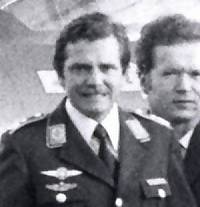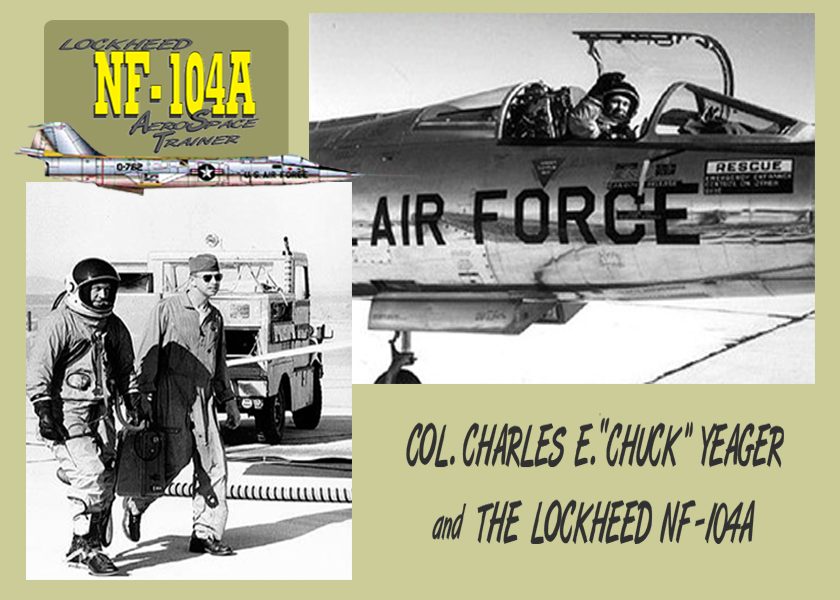Heinrich Thüringer:
Filmszene aus "THE RIGHT STUFF" -
"DER STOFF AUS DEM DIE HELDEN SIND"
|
|
||||
| Vorwort: Ein Freund von schickte
mir eine Mail mit einem Video: Chuck Yeager stürzte mit einer
NF-104 (NF: also mit zusätzlicher Raketenantrieb!!) nach einem
Flug in 104.000 ft (ca. 34.500 m Höhe !!!) in Edwards AFB
ab. Es wurde damals mit einer automatischen Kamera verfolgt und
gefilmt. Da ich wußte, dass Henrich Thüringer bei dem Film "The
right Stuff - Der Stoff aus dem die Helden sind" (1983) die
ganzen Flugszenen mit der F-104 geflogen ist, wollte ich von ihm
doch wissen, ob genau dieser Absturz die Vorlage für die
Filmszene war:
Mehr dazu unter: www.Thexhuters.com
|
||||
|
Die berühmte Absturz-Szene aus dem Film "The right stuff" - "Der Stoff aus dem die Helden sind"
Der Hintergrund zum Film: Erzählt von Oberstleutnant a.D. Heinrich Thüringer. 0 Absturz der NF-104 A im Film „The right stuff“ – „Der Stoff aus dem die Helden sind“ Hallo Herr Dietz, tatsächlich war der Absturz der NF-104A, so wie ihn der damalige Testpilot „Chuck“ Yeager erlebte, die Grundlage für eine Szene in diesem Film. Die Flugaufnahmen wurden im Luftraum über der "high desert" in Kalifornien gemacht. Dazu verlegten der zweite Stunt Pilot, LtCol Patterson (der Staffelkapitän der 69th Squadron) und ich mit 2 F-104 von Luke AFB für eine Woche nach Edwards AFB. Das Filmteam, das die Aufnahmen so realistisch wie möglich machen wollte, stellte sich wirklich vor, dass wir mit dem Flugzeug in den Spin gehen sollten. Erst General a.D. "Chuck" Yeager, als fachmännischer Berater engagiert, konnte das Team davon überzeugen, dass dies unmöglich war. Da man also die Spin-Aufnahmen nicht life machen konnte, wurde mit einem Lear Jet "camera ship" auf folgende, ganz unspektakuläre Weise versucht, das Drehen um die Hochachse und das Abstürzen der F-104 nachzustellen: Ich flog mit der "cleanen" auf Hochglanz polierten Maschine in 15000 Fuß "straight and level" mit ca 300 Knoten. Der Lear Jet hatte in einer kleinen Glaskanzel an der Rumpfunterseite eine Kamera, die sich um 360 Grad drehen ließ und flog von hinten kommend mit Überhöhungen zwischen 200 und 500 Fuß bis zu einem kurzen Abstand zu mir an um dann links zu überholen, vor meiner Nase nach rechts zu schwenken und sich auf der rechten Seite eine kurze Distanz zurückfallen zu lassen.
Insgesamt waren diese zwei oder drei dafür angesetzten Flüge nicht gerade aufregend. Da man mit dem Ergebnis nicht ganz zufrieden war, machte man später auch Aufnahmen mit einem F-104 Modell, bei denen ich dann aber nie dabei war. Für die endgültige Beurteilung dieser Sequenzen und die Auswahl hatten die Produzenten schließlich General a.D. "Chuck" Yeager unter Vertrag, der dem Hörensagen nach für seine gesamte Beratung während der Dreharbeiten den stolzen Betrag von US $ 50.000,00 einstrich. Es entzieht sich meiner Kenntnis, wieviel Filmminuten (-sekunden?) man von welchen Aufnahmen genommen hat. Übrigens, wenn ich mich richtig erinnere, zahlte mir die Produktionsgesellschaft bei freier Unterkunft und Verpflegung 30,00 $ am Tag, die ich bei Abrechnung der Dienstreise natürlich angeben mußte, so dass mir vom Dienstherrn noch ein paar Dollars und cents, gerade mal genug für zwei Bier, ausbezahlt wurden. Es sei noch am Rande erwähnt, dass zur Darstellung des Steigfluges (es sollte der Eindruck "senkrecht in den Himmel" entstehen ) 4 Monate später Flüge in Luke AFB an Wochenenden (wegen geringerem) Flugverkehr durchgeführt wurden. Dazu waren in der Spitze des rechten Tiptanks der F-104 zwei Kameras in einer Glashaube installiert. Eine mit Blickrichtung nach vorne, eine seitwärts, beide konnten vom cockpit per Schalter an- und ausgeschaltet werden. Die Absicht war, den Eindruck der hohen Geschwindigkeit und des Steigwinkels durch Einflug in und nahen Vorbeiflug an den Wolken zu erzeugen. Diese autorisierte "Jagd auf Wolken" hat dann auch Spaß gemacht. Insgesamt wurden zur Unterstützung der Herstellung dieser Unfallszene 10 Flüge durchgeführt, im Film sind von den dabei gemachten Flugaufnahmen maximal 60 Sekunden zu sehen. Trotzdem brachte mir Ihre Anfrage eine für mich erlebnisreiche Episode meines Fliegerlebens in Erinnerung. Anmerkung: Im Film "The right
stuff" ging es um die ersten 7 Astronauten der NASA und die
Antwort der Amerikaner auf der russischen Erfolg mit SPUTNIK,
dem ersten Satelliten der Welt: Im
Film, nach Tatsachen, eine Anhörung bei Senator Lynden B.
Johnson in Washington nach dem "Sputnik"-Schock: |
The famous crash of Chuck
Yeager in reality and in the motion piture "The right stuff"
The background to the movie: by LtCol (GAF ret.) Heinrich Thüringer. The crash of The NF-104 A in the movie picture „The Right Stuff“.
The crash of the NF-104 A as experienced by then test pilot „Chuck“ Yeager was depicted in a sequence in that movie. The in-flight pictures were shot in airspace over Californias high desert. For that purpose the second stunt pilot LtCol Patterson (Squadron Commander 69th Squadron) and I deployed to Edwards AFB with 2 F-104s for a week.
So the camera ship circled me while I was just flying straight ahead. They did this several times with varying distances out and altitude seperations up to 1000 ft. The Lear Jet pilot and a camera man sitting next to him could watch a monitoring screen in the cockpit and would judge the results and decide about the details of the next approach to achieve as realistic scenes as possible. They would direct me into straight descents and climbs and shallow and steep turns to either direction.
By the way if I remember correctly I was paid US $ 30,00 a day by the production company and they provided accommodation in a motel and food on the set. Our Luftwaffe accounting office dutifully took that into consideration when figuring out my travel allowance, deducted an appropriate sum and came up with a few dollars and cents, barely enough to buy me two beers. To conclude the story I should mention that 4 month later we did some more flights in Luke AFB. They took place on weekends (where there was less flying activity). The aim of the game was to illustrate the almost vertical ascent into the sky. For that purpose there were 2 cameras installed in a glass dome in the front part of the right hand tip tank of the F-104. One was looking forward the other one sideways to the right and both could be operated by switches from the cokpit. The intention was to produce a visualization of high climb speed and climbing rate by flying into and passing very close to clouds. It was a lot of fun to chase around the clouds. And it was even authorized.
Nevertheless your request to write down that story reminded me of a very rewarding episode of my flying career.
Note: Both sides of the space race (US and USSR) used experienced German engineers and rocket scientists. In a particularly humorous moment in the film version, Senator Lyndon Johnson attends a meeting where the politicians are reacting to the news of Sputnik's 1957 launch. Senator Johnson asks "Is it their [the Soviets] German scientists that got them up there first?". At that moment, the "German scientist" (a composite character, heavily patterned on Wernher von Braun) responds: "No Senator...our Germans are better than their Germans."
|
|||
| |
||||
|
Unter
http://www.thexhunters.com finden Sie folgenden Artikel
dazu:
On the morning of 10 December 1963, ARPS commandant Col. Charles E. "Chuck" Yeager made two flights in preparation for an altitude record attempt. In the morning he flew NF-104A (56-0760) up to 108,000 feet. After lunch, he took 56-0762 up for another zoom flight. Yeager climbed to 35,000 feet about 100 miles from Edwards near the southern end of the San Joaquin Valley, and headed for the base in afterburner. Yeager ignited the rocket as he was climbing at a steep angle, passing through 60,000 feet with the jet engine flamed out from oxygen starvation. The NF-104A went over the top of its ballistic arc at 104,000 feet. Yeager had planned to re-ignite his jet engine at about 40,000 feet in a dive, but as the angle of attack reached 28 degrees the nose pitched up. The RCS thrusters had no effect, and the aircraft soon entered a flat spin. Without airflow into the jet intakes, Yeager could not restart the engine. He attempted to drop the nose by deploying the drag chute at an altitude of 17,000 feet, but after the chute was released the nose pitched up again. The aircraft continued to spin towards the desert floor.
The aircraft impacted after the fourteenth revolution. Its smashed airframe blasted a hole in the desert several miles north of Mojave. Maj. Robert W. Smith and Phil Neale soon arrived in an H-21 helicopter. They found Yeager standing near the wreck, holding his helmet. He sustained severe burns, but survived to continue a distinguished flying career. The accident investigation found no sign of aircraft failure or systems malfunction |
||||


